






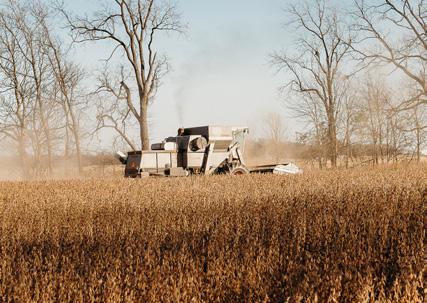




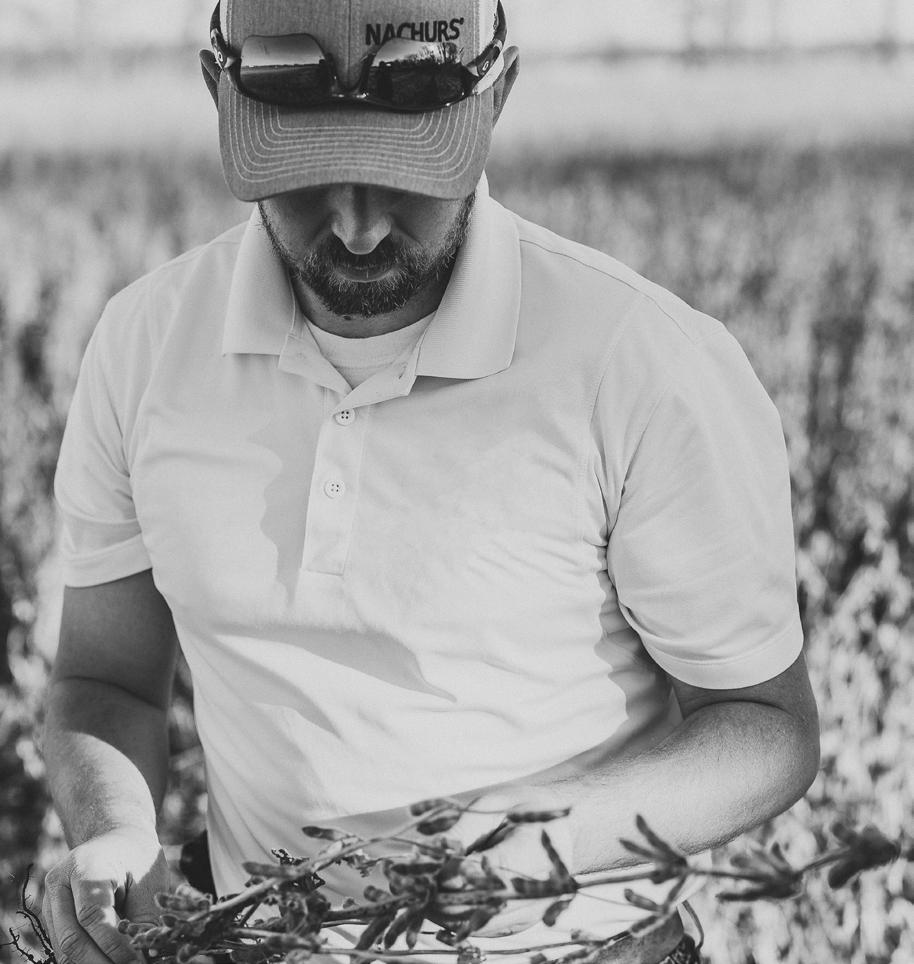
“ They have the right people doing the right things… making sure they are at the table to do whatever is directly beneficial to the farmer.”
-Austin Heil, Hardin County
When the soybean checkoff was created in 1991, there was no way of knowing whether it would be successful or not. By that time, several other commodities, like cotton and dairy, had established successful checkoffs that had shown return on investment, but proof of ROI was yet to be established for the soybean checkoff.
Now — over 30 years later — we have the proof. Every five years, the soybean checkoff is required by the U.S. Department of Agriculture to conduct an economic analysis of the program’s return on investment. The last study, conducted in 2019, showed for every dollar U.S. farmers invest in the checkoff, they receive $12.34 in added value.
But we don’t need a formal economic analysis to see the real world impact our Ohio checkoff dollars have. Throughout this Investor Report, you will see a small sampling from over 125 projects the Ohio Soybean Council (OSC) invested in for 2022. Each project has a distinct impact on the profitability of Ohio soybean farmers.
Thanks to your checkoff dollars, 11 new genes have been discovered that help protect against phytophthora root rot, eight new soybased products have been developed, and nearly 30,000 people visited the website for GrowNextGen, our K-12 education program that helps students build interest in ag careers.
And that’s just the beginning. I’m extremely proud of our accomplishments in 2022, and I can’t wait to see what we achieve in 2023 and beyond. Thank you for your support of the Ohio Soybean Council and soybean checkoff.
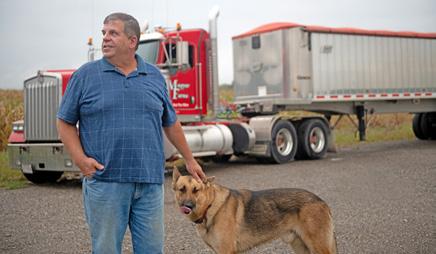
YEAR ENDED SEPTEMBER 30, 2022
ASSESSMENT RECEIPTS FROM FIRST PURCHASERS
$20,412,110 LESS
ASSESSMENT RECEIPTS REMITTED TO THE UNITED SOYBEAN BOARD
$8,743,092
ASSESSMENT RECEIPTS REMITTED TO OTHER STATES
$1,907,654
NET ASSESSMENT RECEIPTS
$9,761,364
INVESTMENT INCOME
$21,712 GRANTS
$81,023

TOTAL ADDITIONS TO THE FUND BALANCE
$9,864,099
ADMINISTRATIVE DISBURSEMENTS
$728,588
TOTAL DEDUCTIONS FROM FUND BALANCE $8,131,675
NET INCREASE IN CASH INVESTMENTS
$1,732,424
BEGINNING CASH INVESTMENTS $8,305,583
ENDING CASH INVESTMENTS $10,038,007
TOTAL PROGRAM DISBURSEMENTS $7,403,087 DEMAND $1,990,961 RESEARCH $2,905,720 COMMUNICATION/EDUCATION $2,506,406
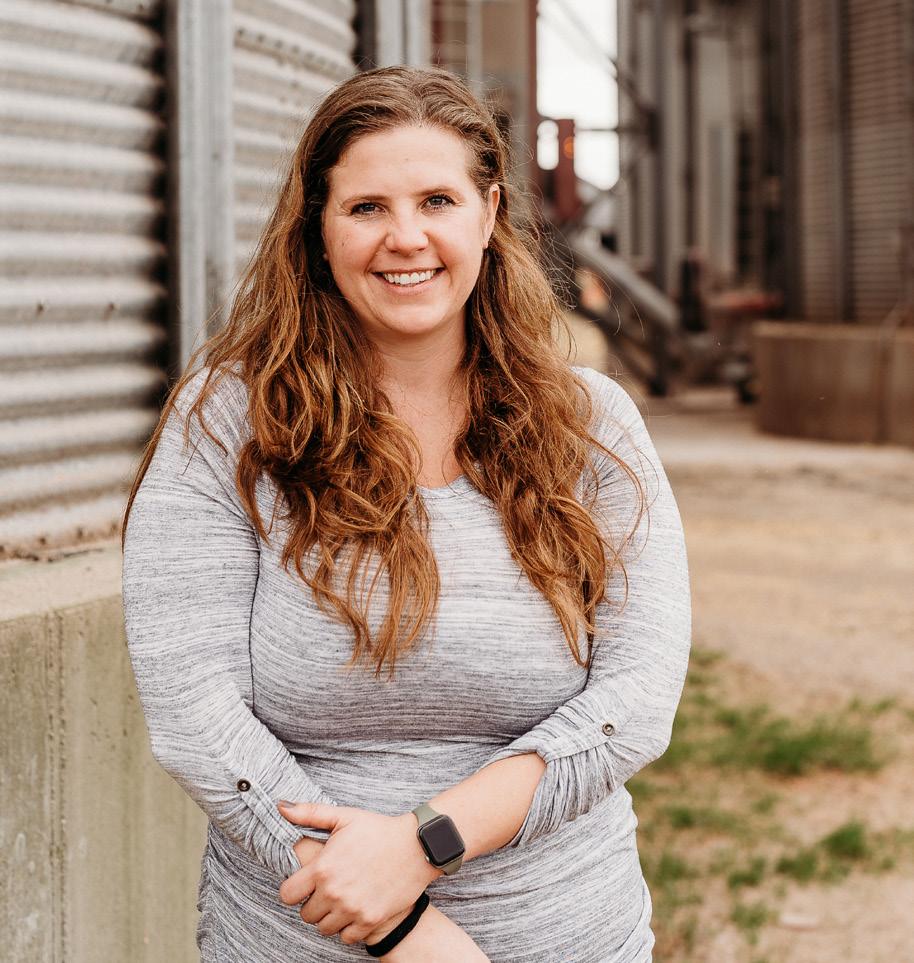
“I see the Ohio Soybean Council as the backbone of what protects our beans. They are working for me and other farmers to help promote the different ways to use soybeans so that they can keep the value strong.”
-Becca Waldo, Ashtabula County
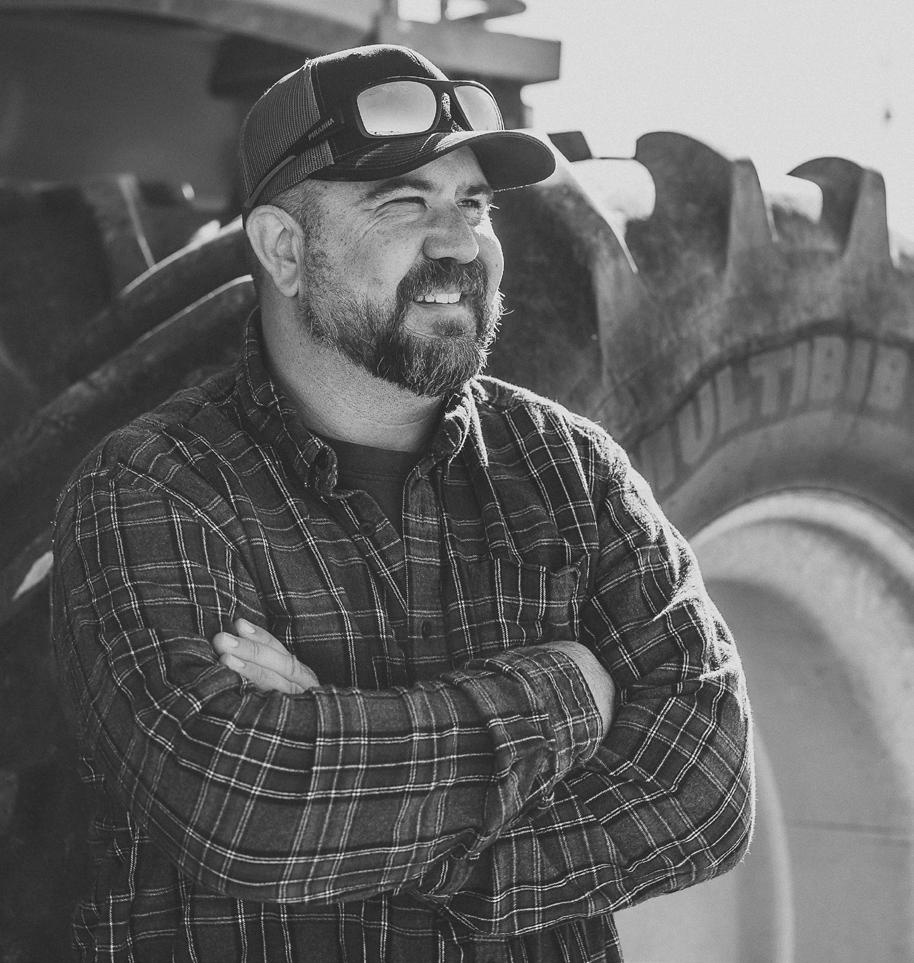
“Collaboration is a big theme with the soybean checkoff, and that’s when the best things happen. We have the opportunity to reach world partners. Not too many farmers can do that alone.”
-Nathan Eckel, Wood County
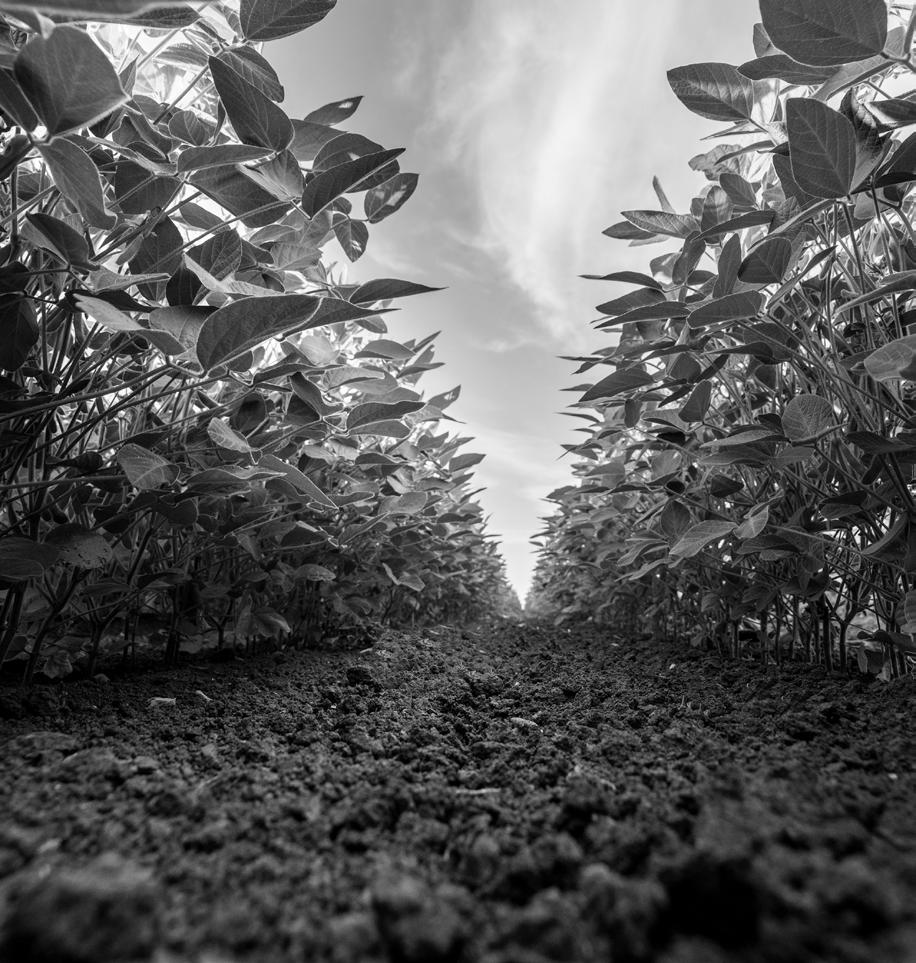
Having the right people do the right jobs makes a massive impact in how far you can go. So while you’re out there focusing on the day-to-day of your operation, OSC and the soybean checkoff are doing what we do best — driving demand for your soybeans. Here’s a quick glance at how we’re putting your checkoff dollars to work for you.
Innovation is at the core of everything we do. OSC is constantly looking for ways to give Ohio soybean farmers an advantage and position our entire soybean industry as a proven leader in agronomic research, technological advancements and new uses for soybean products.
Over half of Ohio soybeans are sent overseas, making international marketing vital to our success. OSC has opened numerous doors in emerging international markets like Egypt over the past few years. We’ve also been increasing domestic awareness of the high-value food grade Ohio soybeans that continue to drive demand in Asia.
Knowledge is power. OSC continually updates and educates farmers and consumers on the role we play in feeding and fueling the world. We also showcase the many ag career paths available to highlight the diverse opportunities available in the ag sector.
From in-lab testing to in-field trials, your checkoff dollars help soybean researchers at The Ohio State University (OSU) provide proven solutions to Ohio farmers’ great challenges and identify opportunities for even greater yields.
OSU researchers are currently working to identify resistant genes and best field management practices for top diseases affecting your soybeans. This includes Phytophthora, Sudden Death Syndrome, frogeye leaf spot, charcoal rot, white mold and more. Thanks to these and other efforts, soybean varieties that have better resistance to disease are now in Ohio fields, decreasing the prevalence of Phytophthora sojae and frogeye leaf spot.
Your checkoff dollars help fund in-field trials that drive soybean production even higher. This includes determining best practices on seeding rate, fungicide and fertilizer use, biological seed treatments, row spacing, cover crops and water quality preservation.
OSC uses checkoff funds to help monitor the soil and pests in our region. By monitoring insect populations and problems in Ohio, we are able to provide soybean farmers with the best practices and education materials for identification and control. One of the top pests we’re monitoring is Soybean Cyst Nematode (SCN), whose population numbers continue to increase. Many SCN infestations go undetected without proper soil testing. Thanks to checkoff funds, all Ohio soybean growers have access to two free SCN soil tests, plus research and strategies for controlling it. In 2022, OSU processed over 300 free SCN tests — the highest number yet performed in one year.

Plant research is also the driving force behind the growth and sustainability of Ohio soybeans. OSC uses checkoff funds to help develop new varieties for specialty premium markets and for disease and pest control. This past year, researchers identified a single gene for a quantitative trait loci (QTL) that is promising for significant yield increases in soybeans. In addition, a precision crop protection system is being developed to help soybean farmers identify and control diseases, weed pressure, insect infestation and defoliation. Also, new economical soil tests are in the works that will provide farmers with more information about their fields — including the effect bacteria, fungi, microbes and nematodes have on soil and plant health.

SCN egg populations can build up quickly in a growing season with little to no visible signs of damage or infestation. In fact, there can be three to six generations of SCN in a single growing season, and each cyst can contain 200 or more eggs. The only way Ohio growers can truly know if SCN is present in their fields is to test their soil. Thanks to funding from the soybean checkoff and The SCN Coalition, Ohio growers can know their numbers by sending in up to two soil samples to The Ohio State University to be tested for SCN — free of charge!
Get started by completing the “Soil Sample Submission Form” at soyohio.org/SCNtest, then follow their tips for how to gather the best sample and send to:
OSU Soybean Pathology and Nematology Lab
Attn: Horacio Lopez-Nicora, Ph.D. 110 Kottman Hall 2021 Coffey Rd. Columbus, OH 43210 lopez-nicora.1@osu.edu




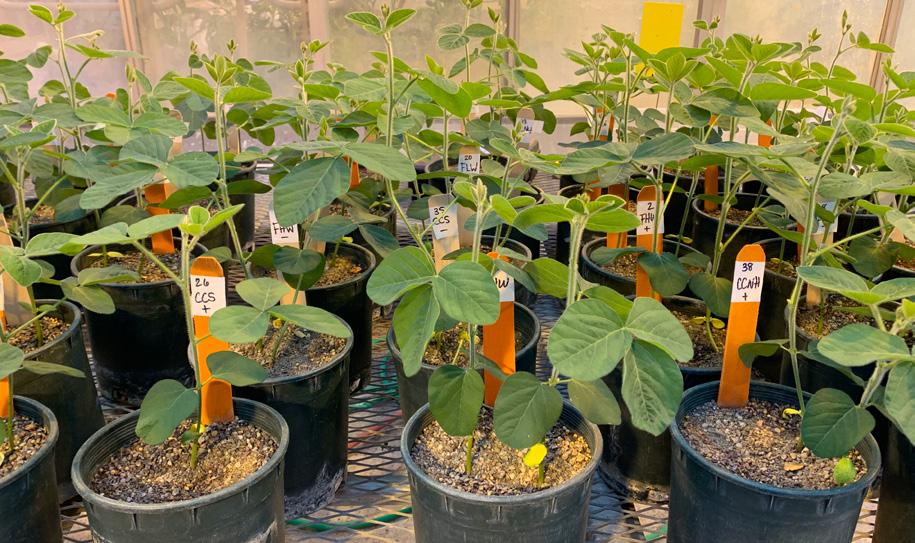
This OSU greenhouse experiment examines the effects of weed pressure on the subsequent infection of SCN, and its associated fungal communities, in soybeans in soils with no previous history of SCN infestation.

Thanks to a soybean-focused research lab created by Ohio soybean farmers and researchers, OSC is leading the way in innovative, soy-based patents, product development and a Fortune 500 partnership, increasing the demand for soybeans and profitability for Ohio farmers.
Our cutting-edge, Ohio-based research lab continues to grow in size and support as it focuses on developing new uses for soybeans. Thanks to soybean checkoff dollars, Airable Research Lab was able to conduct three to four times the amount of research compared to outsourcing it, acquire an additional lab that will double our soy-based synthesis and formulation square footage and add a new chemist and chemical engineer to our development team. That brings our research team total to 10 full-time and part-time engineers and chemists working for you. We have also added two new partners this past year for a total of five soybean states supporting our work. This includes the Iowa Soybean Association, the Illinois Soybean Association, the Missouri Soybean Merchandising Council, the Michigan Soybean Committee and the Ohio Soybean Council. To learn more about the checkoff-funded new uses research, visit AirableResearchLab.com.
A FORTUNE 500 PARTNERSHIP
Airable continued to build its relationship with Stanley Black & Decker. Two soy-based retail products were released from Stanley Black & Decker this past year under the DEWALT brand: a soy-based bar & chain oil and a soy-based degreaser. Both outperform competitor brands in use, effectiveness and sustainability, and are now available in retail stores across the nation. More Stanley Black & Decker products will be coming soon from Craftsman and other tool companies owned by this Fortune 500 company.

Through a partnership with LFS Chemistry, Airable developed and licensed a soy-based scale-inhibitor for the upstream and downstream oil and gas industry, which has a significant need for scale inhibitors. Scale is the term for insoluble minerals that accumulate in water systems, slowing production and eventually damaging equipment. Airable started with a proof-of-principle project and worked with LFS to develop and modify a formulation that met the client’s needs. Once created, Airable filed a provisional patent for the formulation and transferred the technology to LFS, which is using its oil and gas experience to commercialize the product. The trade name will be Reactiv SCC and will be available as part of LFS’s Farm-to-Wellhead suite.
Airable assisted two small soy-based companies with improving their technologies and increasing their soy content. With Airable’s support, Sofia’s developed a soy-based surfactant to replace their petroleum-based multi-surface cleaner without compromising performance. Airable also helped Gear Head update their Fifth Wheel Grease Pads. Through these efforts, they were able to increase the soy content from 60% to 95% and improve shelf stability over the petroleum-based material they had been using.
CATIONIC SURFACTANT
Airable synthesized a bio-based cationic surfactant that can replace more toxic products. This product provides a secondary environmental benefit: a unique technology that sequesters greenhouse gases by consuming CO2 in synthesis.
CORROSION INHIBITOR
Airable developed a soy-based additive that inhibits corrosion in water-based systems. The additive targets ferrous metals found in oil-producing wellbores, water systems involving cooling tower evaporators, heating systems and steam generators. Airable’s product contains 54% soy content and in-house studies have demonstrated up to 89% corrosion inhibition.
SHRINK-REDUCING ADDITIVE
Airable synthesized a soy-based shrinkage-reducing additive (SRA) for concrete, minimizing concrete shrinkage that causes strain and damage (e.g., cracks) in cement structures. Most SRAs are petroleum-based with associated environmental and supply chain issues. The Airable product is derived largely from biological substances with up to 72% soybean-derived feedstocks. The soy-based SRA reduces interfacial tension by as much as 60% and internal strain and shrinkage by up to 80%.
SOYLICONE
Airable synthesized a renewable, soy-based oil that can replace silicone oil in formulations. The product can be used as a low-temperature silicone replacement in formulations (polishes and lubricants) with broad potential applicability from home DIY projects to industrial uses.

B Y THE NUMBERS
2
8
12
25
2
PROVISIONAL PATENTS SUBMITTED
NEW TECHNOLOGIES DEVELOPED
COMMERCIAL COMPANY PROJECTS
NEW COMPANY PARTNERSHIPS
NEW STATE SOYBEAN ASSOCIATION SPONSORS
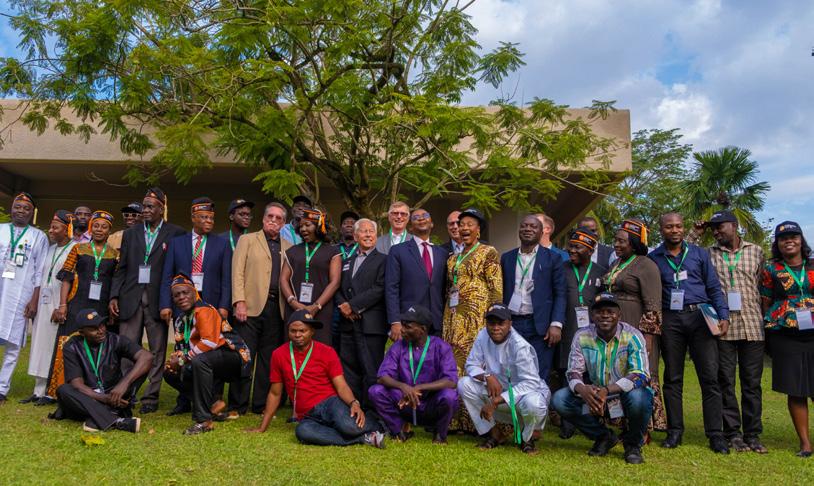
OSC continues to find innovative ways to connect with international buyers, build relationships in emerging markets and promote high quality Ohio soybeans to people across the world.
Ohio Soybean farmers and their checkoff have had a huge hand in creating the two new Soy Excellence Center locations in Africa: Egypt and Nigeria through the U.S. Soybean Export Council (USSEC). Both were founded in 2019, but the long-term impact continues to be realized. U.S. Soy is now the largest soybean supplier to Egypt. In marketing year 2021/2022, Egypt was the fourth largest export market for Ohio soybeans.

The Soy Excellence Centers provide training and educational opportunities to food and agricultural industries in emerging market regions. These programs include training in poultry management, aquaculture management, feed milling efficiency and crush efficiency. Combine these Africa-based efforts with Soy Excellence Centers in the Americas and Thailand, and over 1,000 trainees have completed these valuable food and agriculture programs. That’s onthe-ground proof of your checkoff dollars driving more demand for soybeans around the world.
1,000+
Over 600 soybean industry leaders convened in San Diego, CA for SoyConnext, a global U.S. Soy Summit that took place in August 2022. OSC board and staff represented Ohio soybean farmers at the gathering that hosted over 60 countries.
OSC welcomed two trade teams back to Ohio for the first time since 2019! The Japan Tofu Future Team brought 11 soy industry leaders and included visits to Schwartz Farms, The Ohio State University, KAPI and Bluegrass Farms of Ohio. The Korea Soy Food Team also brought 11 soybean leaders and included visits to OSC Board Member Scott Metzger’s farm in Ross County, CGB’s facility in Cincinnati, Rogers Grain and Bluegrass Farms of Ohio.
USSEC developed an online education program on soy foods and U.S. food beans known as the Soy Food Masters Program. This project, funded by Ohio checkoff dollars, promotes soy foods processed from U.S. food beans to the dietitians in the food industry.
Last year, a total of 250 people registered for the Soy Food Master Program, and USSEC selected 122 Soy Food Masters based on their program participation and qualification test. USSEC also hosted the Soy Food Master Awards & Recipe Contest on July 28 to recognize the Soy Food Masters and the soy food recipes submitted by dietitians for group meals. A pre-recorded message from Clark County farmer Bob Suver was also shared at the event.
Logan County farmer Bill Bayliss represented Ohio at two Soy Buyer Conferences in mid-November last year — the Japan Outlook Conference and Korea Outlook Conference. Both events were attended by hundreds of major stakeholders, including soybean importers, crushers, refiners, brokers, oil sectors and food grade buyers. Bayliss provided updates on conventional and non-GMO production of soybeans in the U.S. as well as personal commitments to providing quality soybean products to customers and ongoing efforts to develop the most sustainable crops possible. He also attended U.S. Soy Connext Trade Summit Europe, Middle East and North Africa, which took place in December 2022, in Paris, France. Here, he participated in a panel discussion called “Fresh From the Field, U.S. Farmer Insights.”
The USA Poultry and Egg Export Council’s (USAPEEC) Poultry Meat Processors Educational Program helped increase indirect exports of U.S. soybeans by increasing exports of U.S. poultry products to Mexico. The program supports local processing companies to continue to push themselves to launch new value-added products made with poultry proteins to the public. OSC sponsored the Mexican Association of Specialists in Poultry Science’s (ANECA) 15º Poultry Processing and Food Safety Course.
Through OSC’s support, USAPEEC Mexico increased its visibility and influence among poultry and meat processors. It also continued identifying local meat processors and developing new value-added products made with poultry ingredients. Altogether, these companies (working with support from USAPEEC, OSC and other state soybean checkoffs) launched 13 new value-added products to the market in 2022.
Trumbull County farmer Dan Schwartz hosted 11 food-grade buyers from Japan on his farm in August 2022.
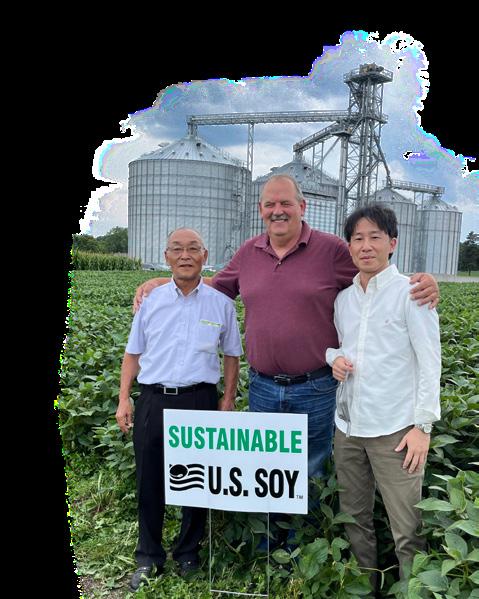

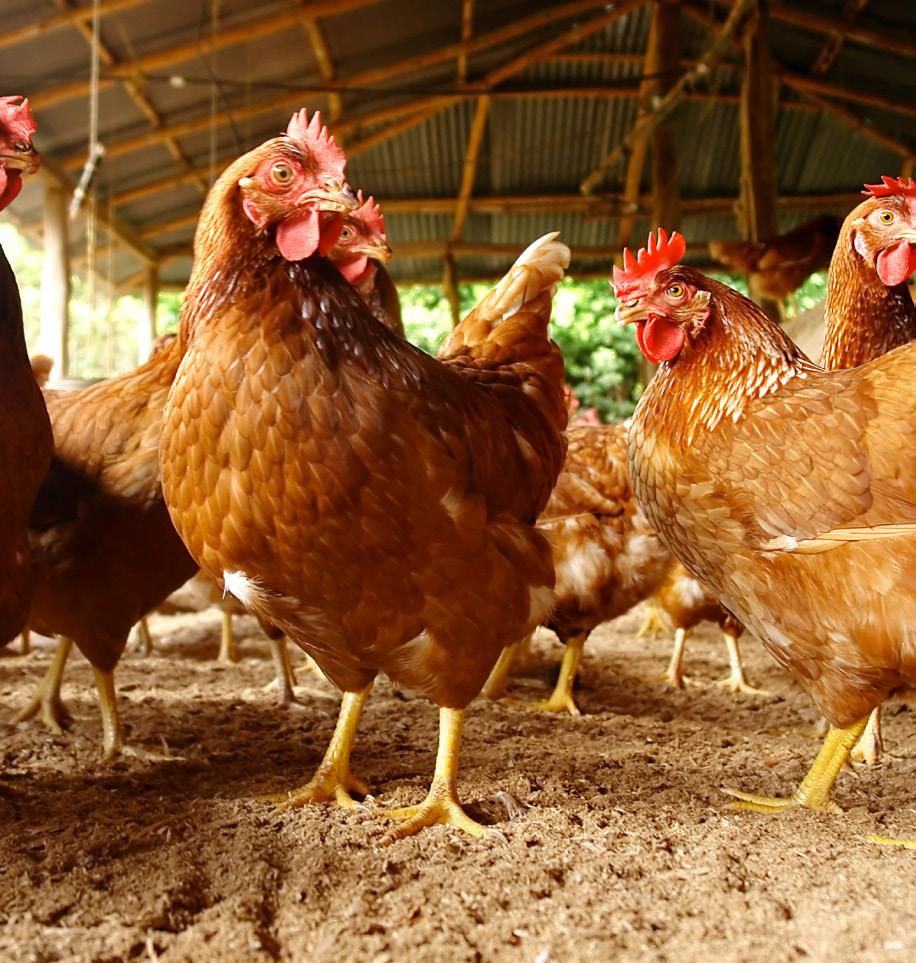

Fifty thousand pounds of chicken equals 23,000 pounds of soybean meal. Recognizing our soybean farmers succeed when animal agriculture succeeds, OSC collaborated with the Ohio Pork Council and Ohio Poultry Association to help increase demand for chicken and pork. Through our 2022 Ibotta project, we were able to reach over 200,000 consumers with coupons for pork and chicken and tallied 64,618 product purchases after media exposure.
OSC continued supporting the Soy Transportation Coalition (STC) in its efforts to increase awareness of the importance of infrastructure in the soybean industry. Checkoff funds helped them explore solutions to more effectively transport soybeans and soy products and promote those solutions on a local and national level. Both the U.S. and the Ohio soybean industry are increasingly reliant on transportation to remain viable. STC was a resource and strong promoter of the need for reliable transportation during the struggling times of low Mississippi River water levels and threat of a rail strike.
Biodiesel adds 13% to today’s value of a bushel of soybeans. The future of biodiesel, renewable diesel and sustainable aviation fuel is bright with marine, rail and home heating oil in high demand. To help continue driving demand for biodiesel, OSC supported efforts by Clean Fuels Alliance America (formerly the National Biodiesel Board) and Clean Fuels Ohio to promote biodiesel and renewable diesel production and use.

Creating a sustainable soybean industry means educating the next generation about the importance of agriculture and generating interest in the field. OSC engages Ohio students and teachers through key workshops and programs every year to help grow understanding and interest throughout the state.
GrowNextGen is promoted around the state and country as a one-stop shop for premium curricula, e-learning courses, student activities, career information and virtual learning opportunities for K-12 students. Here’s a look at how its many resources were utilized by classrooms and teachers throughout the state in 2022.
GrowNextGen Website
The GrowNextGen website rolled out new curricula and new classroom activities in 2022. All e-learning courses were also updated and refreshed, maintaining its position as a valuable resource for students and educators.
28,328 UNIQUE VISITORS*
6,873 E-LEARNING COURSES UTILIZED*
2,590 CAREER VIDEOS VIEWED*
9,492 MONTHLY NEWSLETTER SUBSCRIBERS*
*Statistics pulled from 10/1/21-9/30/22
GrowNextGen Workshops & Virtual Assembly Program

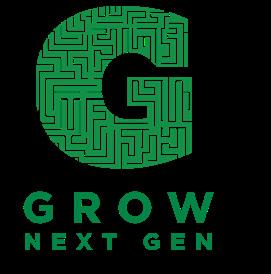
One hundred thirty teachers participated at GrowNextGen workshops at national teacher conventions throughout the year while the GrowNextGen Virtual Assembly Program with Fusion Marketing went to 20 schools with nearly 3,500 elementary students in 2022.
GrowNextGen Ambassadors
Fourteen college students made up GrowNextGen Ambassadors for 2022 and they far exceeded the goal of reaching 15,000 direct contacts. Representing OSC and GrowNextGen at virtual and in-person events this past year, GrowNextGen Ambassadors reached over 31,000 participants. They also represented OSC and GrowNextGen at after-school programs, community events, farm days, county fairs, summer camps and the Ohio State Fair.
GrowNextGen 4-H Program


A summer GrowNextGen 4-H program focusing on drones and soybean production reached 2,000 students at 4-H camps and over 1,000 at the Ohio State Fair. This program was developed and executed by OSU’s Dr. Bob Horton with the help of extension educators around the state.


GrowNextGen Tour
Ohio’s Country Journal and Ohio Ag Net continued their GrowNextGen tour highlighting activities at 10 events around the state. The events are highlighted in interviews on Ohio AgNet, posted on ocj.com, and featured in podcasts and the Digital Dale e-newsletter.
GrowNextGen Meetings
A variety of meetings took place in 2022 that encompass GrowNextGen and other education-related topics. These included discussions on incorporating the USB CHLOE program at OSU’s Waterman Agricultural and Natural Resources Laboratory, expanding the facility at the Global Impact STEM Academy (GISA) in Springfield, OH, and giving soybeans to students at the Columbus Council on World Affairs Global Scholars program.
OSC’s ChickQuest elementary school program continues to prosper. Four workshops took place in 2022 (January, March, August and December) with 178 teachers in attendance.
Five virtual field trips were made available in 2022 featuring Wood County farmers Nathan Eckel and Andy Stickel, and T. Marzetti and Company. During these tours, 228 classes and 4,147 students directly participated in a live, behind-the-scenes look at ag life. An additional 577 classrooms registered for the tours and had recorded versions of the trips available for use. This provided another 12,300 students with insights into agriculture.
OSC helped fund four other teacher-focused workshops last year. This includes Ag & Med Biotech with 34 teachers in attendance, Ag Biotech Academy with 25 teachers, Field to Package with 24 teachers and Exploring Soil & Water with 23 teachers.
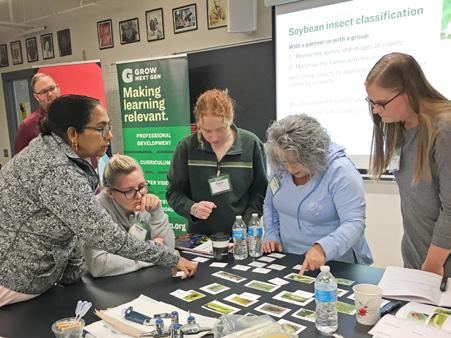
Teachers at the Ag & Med Biotech workshop sort insects to discuss their relationship to soybeans.

GrowNextGen ambassadors help students compare soil texture to common food products like sugar, flour and peanut butter.
Helping farmers grow their operations and make the best decisions for their farm is a top goal of the soybean checkoff. These valuable OSC programs and platforms are key to helping growers stay on top of the latest research, innovations and industry.
OSC launched a Managing for Profit program with Brownfield known as the “Voice of Soy” in 2022. So far, 42 three-minute episodes have been produced. The episodes play on all the Brownfield stations in Ohio and are also available online.
In February, OSC hosted the first edition of the Night for Young Professionals since before COVID-19. This event, in partnership with the OSU Ag Communicators of Tomorrow, allowed students the chance to learn more about what it will take to get a job in the agriculture industry post-college, and included free headshots and a panel with resume, interview and first job tips.
OSC won the Region 6 Best of NAMA Merit Award for our GrowU young farmer education program. In 2022, we added four additional videos, covering data management, transition planning, long-range planning and conservation.
The program is available at soyohio.org/GrowU
OSC worked with four other state soybean boards to publicize the Future State of Soy Research (futurestateofsoy.org), which was launched on the Main Stage at Commodity Classic.
OSC staff attended 19 farmers markets around Columbus (Bexley, Upper Arlington and Clintonville) to talk with consumers about modern farming and soybeans. This tour also offered us a chance to talk to hundreds of urban consumers about row crop production.

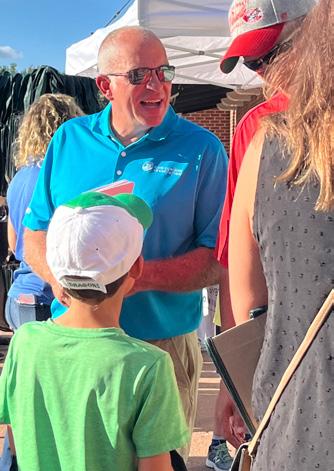
Throughout the growing season, OSC hosted farmers in seven counties for the Ohio Field Leader Roadshow. The roadshow visited farms that are implementing unique practices to get the word out about specialty opportunities, conservation practices and more.
The series can be found at ocj.com
OSC attended the OSU vs. Iowa basketball game in January as part of our OSU Athletics sponsorship and two Fan Fests at the Iowa and
Wisconsin Ohio State football games to engage with consumers. We had a table with a trivia game where participants could earn a bandanna with soybean facts. This was highly successful with lines of people to the door, eager to play our game.
In August, OSC was a featured partner at a Dayton Dragons baseball game. We had a booth in front of the ballpark to pass out information about farming and Shelby County farmer Patrick Knouff threw the first pitch.
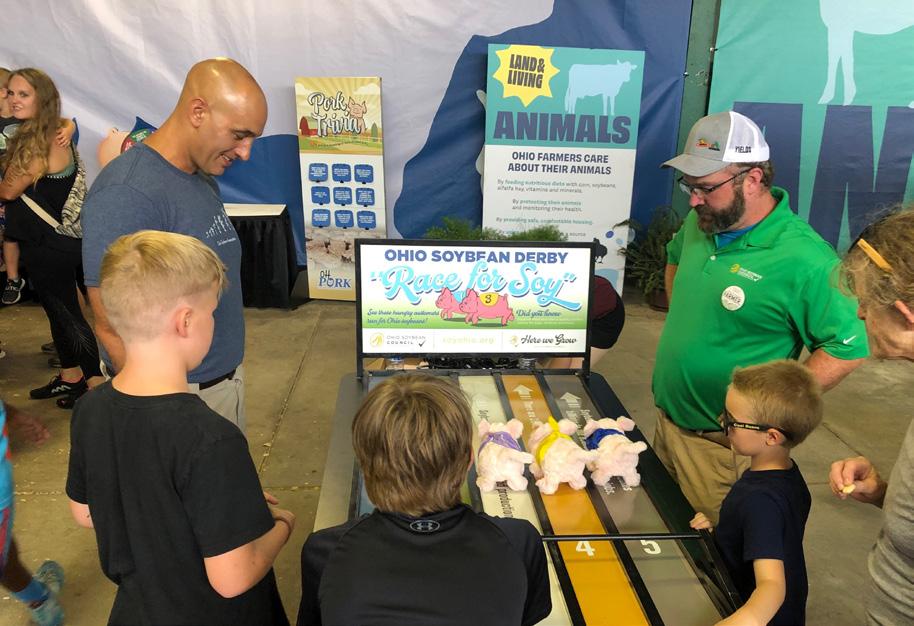
As a grassroots organization, the Ohio Soybean Association (OSA) works to provide leadership for Ohio’s soybean farmers by promoting policies and legislation that ensure a growing and profitable industry. These are some of our successes from the past year.


The agricultural linked (Ag-Link) deposit program offers farmers a discounted loan rate on operating lines of credit. OSA advocated for a bill that removed the statutory program loan cap and overall cap, leaving it to the Treasurer of State to decide. It also makes agricultural cooperatives eligible to borrow under Ag-Link. This will help farmers finance upfront operating costs for feed, seed, fertilizer, fuel and other expenses.
Starting in 2023, this legislation allows for an income tax credit for beginning farmers who attend a financial management program and a credit for individuals or businesses that sell or rent farmland, livestock, buildings or equipment to certified beginning farmers.
Double crop insurance opportunities were expanded for soybeans in at least 681 counties nationwide, covering almost all Ohio counties. This will allow farmers in the Buckeye State to reduce the economic risk associated with growing two crops on the same land in the same year.
OSA successfully urged the U.S. Environmental Protection Agency (EPA) to review and approve the use of Enlist One and Enlist Duo in 134 additional counties, including several counties in Ohio.
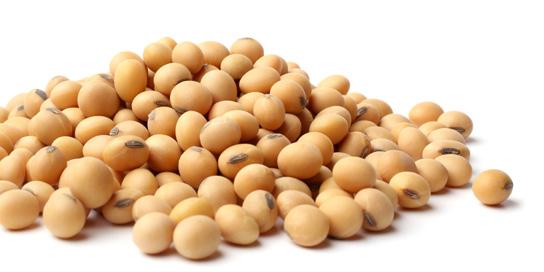

WERE ADDED THIS YEAR, in addition to continued support from long-time partners.

THIS SHOWS COMPANIES SUPPORT THE WORK WE DO FOR OHIO FARMERS.


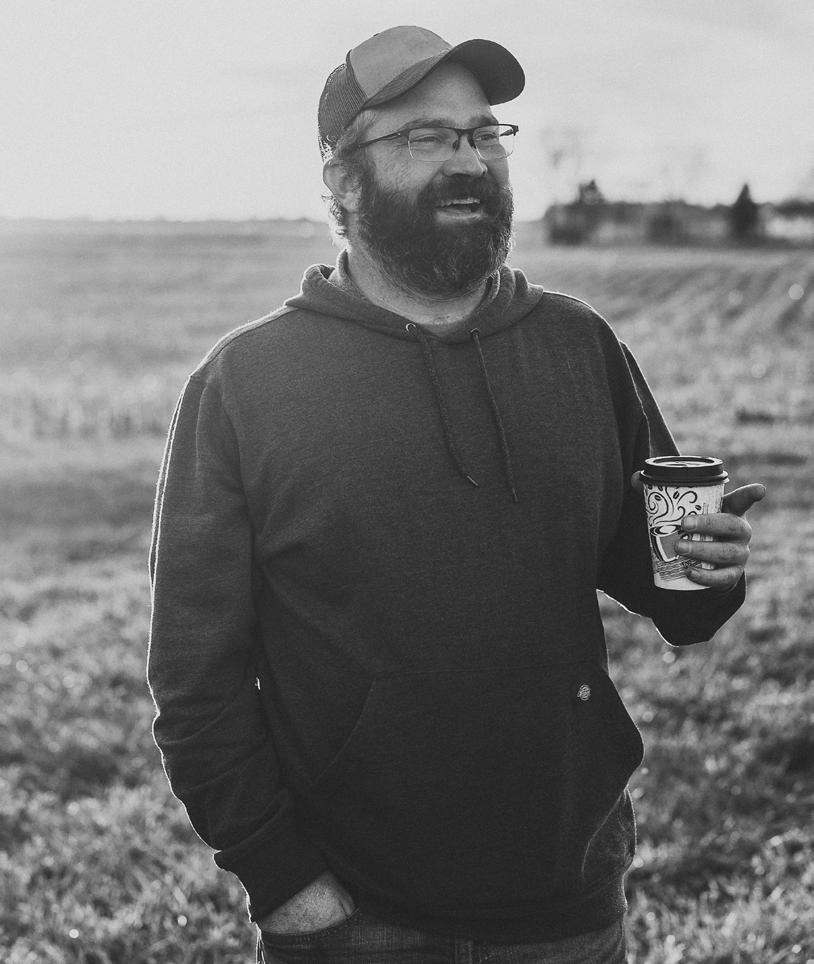
“ There are so many markets and opportunities out there. It would be impossible for a farmer to keep track of them on their own. The Ohio Soybean Council gives us a lot of opportunities to increase our bottom line.”
-Tyler Miller, Crawford County
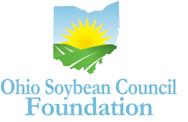
The Ohio Soybean Council Foundation (OSCF) was established in 2007 to extend the soybean checkoff’s impact through special initiatives and programs that advance the application of science and technology to agriculture today and tomorrow.
In its 15th year, the OSCF Scholarship Program awarded eight $3,000 scholarships and one $5,000 undergraduate scholarship, as well as four graduate scholarships of $4,000 each. Since 2008, the program has awarded over $450,000 in scholarship funds to students studying agriculture or a related field at Ohio colleges or universities.
OSCF supported district and state science fair competitions throughout Ohio for the 15th year. Nearly $6,000 was awarded to 47 Ohio students for their projects related to the soybean industry.
OSCF is a key funding partner of valuable workshops that bring biotechnology lessons to Ohio classrooms through in-depth teacher training. Twenty-five teachers attended the 2022 Ag Biotech Academy Workshop, which was jointly funded by OSCF, OSC and Pioneer. This was the 10th year for the workshop.

“ The Ohio Soybean Council is constantly working If we don’t have anybody to use our products,
working
products,
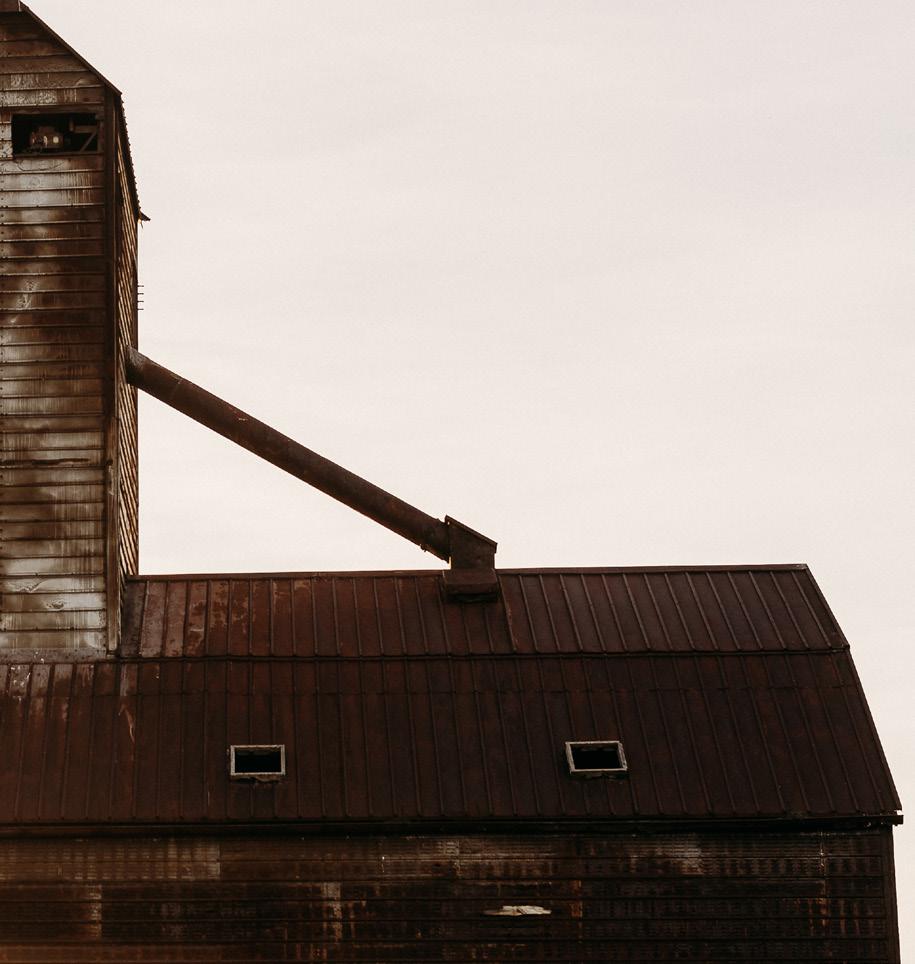
$45,000 In OSCF Scholarships WERE AWARDED IN 2022. 300+ Teachers
••• ATTENDED ••• AG BIOTECH WORKSHOP SINCE 2012.
on things that will help drive demand.
it doesn’t matter how much we produce.”
-Andy Stickel, Wood County
JEFF MAGYAR
Chairman
District 3
Ashtabula County
United Soybean Board (USB)
BILL BAYLISS
Vice Chairman
Ex Officio
Logan County
United Soybean Board (USB)
CINDY LAYMAN
Treasurer
District 8
Hardin County
Clean Fuels Alliance America
NATHAN ECKEL
Secretary
District 2
Wood County
TODD HESTERMAN
District 1
Henry County
MIKE HEFFELFINGER
District 4
Van Wert County
TYLER MILLER
District 6
Crawford County
JERRY BAMBAUER
District 7
Auglaize County
Soy Aquaculture Alliance (SAA)
MIKE RALPH
District 9
Marion County
SCOTT DENLINGER
District 10
Montgomery County
BOB SUVER
District 11
Clark County
World Initiative for Soy in Human Health (WISHH)
DAVE DOTTERER
District 12
Wayne County
United Soybean Board (USB)
DAVID CLARK
District 13
Warren County
North Central Soybean Research Program (NCSRP)
Soy Transportation Coalition (STC)
SCOTT METZGER
District 14
Ross County
STEVE REINHARD
Ex Officio
Crawford County
United Soybean Board (USB)
Soy Transportation Coalition (STC)
The Ohio Soybean Council (OSC) was founded in 1991 to manage the Soybean Promotion and Research Program, more commonly known as the soybean checkoff. OSC is governed by a volunteer farmer board, which directs the investments of the checkoff. The program’s primary goal is to improve soybean profitability by targeting research and development, education and promotion projects.
918 Proprietors Rd., Suite A Worthington, OH 43085
888-SOY-OHIO
PHONE: 614-476-3100
SOYOHIO.ORG